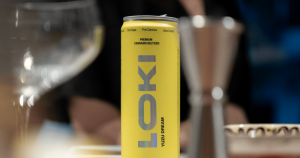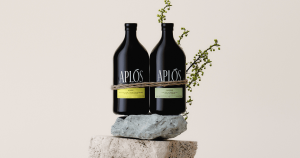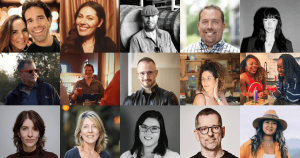By Martha Wright, Founder of Clear Power Coaching
As a Sobriety Coach (and a Senior Coach with This Naked Mind), I’ve worked with hundreds of clients, men and women, ages 22 to 82. Primarily, it’s women in their 40s and 50s who have come to me because of what they deemed “a problem with alcohol.” My clients are gray area drinkers, not chemically addicted. That means they’re drinking more than they want. For them, there has been no rock bottom—not even close. But they feel fixated and stuck in a rut.
Five years ago, I felt exactly like they did: exhausted and baffled as to why the boundaries I tried to put around my intake didn’t stick. Frustrated as I lost confidence in myself that my middle of the night promises vanished into thin air come wine-o’clock time. Worried because my brain felt fuzzy.
Within a few coaching sessions, my clients can see as it clearly as I did myself: that alcohol is not the problem, it’s the symptom. That they don’t have an alcohol issue, they have a #becausehuman issue. Just like we all do. Humaning is hard. And none of us got the manual.
Here are nine of the top areas that my clients—and most of us—get tripped up on and where our opportunities for growth lie:
1. The belief that negative emotions should be ignored or vaporized on demand
My mother was visiting us when we found out that my mother-in-law had been diagnosed with lung cancer. I was standing at the kitchen counter as a few tears slid down my face. “You’re going to have to do better than that,” she told me. She was instructing me and doing the best she could with the tools she had been given during her own 1940’s childhood in the South. Don’t cry, stiff upper lip, be a rock for others, change the subject, the less said the better. Or maybe it shows up in our own thinking: “I should feel so fortunate. Others have it worse and I need to count my blessings.” We were taught to disavow our feelings.
What were you instructed as a child from well-meaning adults? “Stop crying.” “Green doesn’t look good on you,” i.e., jealously is ugly. “At least he/she died doing what they loved,” i.e., don’t grieve. “You should be grateful,” i.e., don’t complain and desire. None of our human emotions are accidents or throwaways. Each one is an indicator light with important information for us. Brené Brown has done the world an immense service with her Atlas Of The Heart, which explores 87 distinct human emotions and their purposes, with the intention of increasing our emotional fluency. Brown’s research showed that people can identify an average of only three distinct emotions. Without language, she says, we can’t understand our emotions and then have no hope of communicating them to others.
2. Supreme discomfort with discomfort
All of us. We have a hard time sitting in discomfort. With so much technology in our palms, we’re getting much worse at it. We’re uncomfortable with uncomfortable conversations. We’re uncomfortable waiting or with silences. With boredom. With being with ourselves.
If you can relate, you’re not alone. Humans are wired to move from pain toward pleasure. So we buffer. We numb. We reach for the remote, the Instagram likes, the carbs, the drinks, the gummies, the porn… or my favorite of the moment: Zillow. We often buffer by overworking or insisting on being right all the time.
But practicing sitting with discomfort can be your superpower! What happens when we challenge ourselves to sit alone in a public space such as a bar (drinking a non-alc cocktail), a doctor’s office, or an outdoor cafe without reaching for our phones.? Or when we push ourselves to show up somewhere where we know no one, or to travel solo? Or when we allow our emotions without making them so personal. Having the thought, “I’m feeling present to some jealousy and I wonder what that is trying to tell me” versus “I’m a jealous person.”
3. A misunderstanding about expectations that creates more misunderstandings
For expectations to be valid, they need to meet four criteria: they must be conscious, communicated, agreed upon, and realistic. That goes for expectations we have of ourselves as well! I’d say all of us are walking around with expectations that we haven’t examined, that we’re often not even conscious of, and that might not even be our own (!!!). These expectations can’t be satisfied. They leave us feeling misunderstood or mistreated.
4. A resistance to human resistance
An enormous part of our brain wants only to stay alive by saving energy. That means doing what is easy and familiar. Understanding this takes a huge weight off, because most of us are over-identifying with our basic human resistance. We’re telling ourselves that we’re lazy and undisciplined because we can’t seem to motivate ourselves to get out the door to go to the gym or learn something new. Once we stop making it feel personal, we can study the habit experts and set up a better system to overcome this human wiring and achieve our goals.
5. Doing unto others what they never give themselves
Basically, we’re horrible to ourselves! I find that women understand this immediately. We know that we’re excruciatingly self-critical. My male clients sometimes resist until they start paying attention and catching more of their self-talk. It can be brutal. With others we can be forgiving, supportive, and empathic in ways that we deny ourselves.
Mel Robbins’s High-5 Habit has you give yourself a high-five in the mirror five days in a row. You meet your own eyes and you give yourself a high-five because you deserve it just because you’re you! You’re alive and you’re the only one you will truly be with for your entire life.
6. Not seeing self-care and self-compassion for the herd immunity that they are
We’re ministering to others and putting ourselves last. Most likely, we were taught that self-care is indulgent. This is a hard one to let sink in. We say, “I know, I know… I should do that,” but then we still put it last. Thankfully, people are sharing more than ever before about mental health, and we’re more conversant about the cost of denying ourselves proper rest, play, nutrition, and love. It shifted things for me to see self-care and self-compassion more like vaccinations. It’s not just about me. It’s for the good of the herd.
7. Falling into the assumption gap
Leadership author and speaker John Maxwell talks about the Assumption Gap as one of the ways we misunderstand our potential. As kids, we didn’t need to do anything to learn and grow. It just happened. Each year, we were bigger, stronger, and smarter. No one told us (did they?) that, as adults, it would be up to us to keep growing, stretching, learning, and evolving. The theory of entropy says that matter left alone in a closed system devolves. The solution is intentionality. We can put intentionality (real time and intention) into cultivating relationships or continuing to learn.
8. Going down the rabbit hole with ANTS (Automatic Negative Thinking)
Dr. Daniel Amen coined this term to explain that human beings come pre-wired with a negativity bias. Focusing on what could go wrong and constantly scanning for danger kept early humans safe. We have up to 60,000 thoughts a day. Would you believe that most of them are not true? And the majority are repeats from the day before and the day before that. Amen identifies nine “species” of ANTs including fortune telling (negative thoughts about the future) and mind-reading (negative thoughts about the thoughts of others).
One of the biggest cornerstones of the work I do is helping clients learn to question their own thinking. Who knew that was even possible and that it turns out to be a major superpower? Using the work of Annie Grace and Byron Katie we can ask, “Is this true? How can I know it’s true? How do I feel when I think this thought? How do I behave or show up when I think this thought? What would I feel like and be like if I didn’t have this thought? How can I cultivate having that feeling instead? Is there another thought as true or more true than the original thought, and what does that shift for me?”
9. Playing pinball games
Without the #becausehuman manual that we all needed but didn’t get, life can feel like we’re the pinball getting whacked around without any control. It can feel like we have emotions we don’t understand and are afraid of. We have expectations that we’re not even conscious of. We might have unmet needs or unrealistic expectations of ourselves or placed on us by outside forces. Our own human negativity bias can result in repetitive thoughts that don’t serve us, yet we’re unaware that we actually can redirect them. We can also choose to get out of our overly busy minds and back into our bodies on the regular via exercise, dance, tai chi, meditation, or activities that get us into flow.
A journey of discovery of these concepts can reset the game, so that we’re no longer the pinball but the fingers on the flippers, directing the play.
So, absolutely, I first arm my clients with science-backed tactics and knowledge that help them question the role alcohol is playing and even to take a 30-day break. All the while, I’m coaching them to see that alcohol was really the symptom all along. And that they aren’t “broken” or “projects to fix or complete.” Examining, learning, and sowing these concepts into our life “gardens” is a life-long journey and privilege. It’s supposed to take our whole lifetime, this human “becoming” thing.
About the author
Martha Wright is a New Orleans-born wine industry veteran turned sobriety/mindful drinking coach working in small groups and 1:1 in her own practice, Clear Power Coaching, as well as serving as Senior Coach within This Naked Mind. Using her background as a winemaker and right-hand to Food Network chefs, her unique path to regaining control focuses on kicking up the lusciousness and fun in our lives (plus, of course, understanding the neuroscience of habits, uncovering unconscious beliefs, and honing coping tools). She splits her time between Paris, Portland, Oregon, and New Orleans where you can find her sleuthing out the best street-food markets, coffee shops, and non-alcoholic venues, hosting non-alc meet-ups, or playing ping pong.






